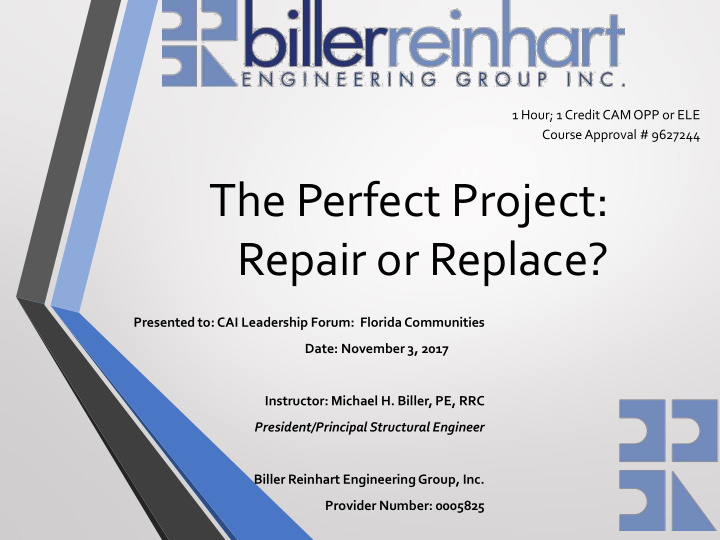



1 Hour; 1 Credit CAM OPP or ELE Course Approval # 9627244 The Perfect Project: Repair or Replace? Presented to: CAI Leadership Forum: Florida Communities Date: November 3, 2017 Instructor: Michael H. Biller, PE, RRC President/Principal Structural Engineer Biller Reinhart Engineering Group, Inc. Provider Number: 0005825
Elements of Your Imagination I. Unicorns II. Leprechauns with Pots of Gold III. Genie in a Lantern IV. A Perfect (Restoration) Project
Overview I. Introduction II. Repair or Replace? III. A “Perfect” Project IV. Discussion
Introduction
Role of the Engineer I. Define the Project a. What does the client want? b. What does the building need? II. Design the Project III. Implement the Project
Repair or Replace? What factors are considered?
Repair or Replace? I. Condition of the component/system II. Age of the component/system vs. its intended service life III. Area affected by the component/system failure and restoration, impact on occupancy IV. Cost to repair and maintain vs. the cost to replace V. Building code required upgrades VI. Aesthetics VII. Safety VIII. Quality of Construction IX. Accessibility to make repairs
Repair or Replace? Example - Roof After Before
Example – Roof (removed/replaced) I. Condition: deteriorated, repairs becoming more frequent II. Age: beyond its intended service life III. Area affected: building interior IV. Costs to repair and maintain escalating with time V. Building code required upgrades: A/C supports VI. Impact on occupancy: contractor’s exterior staging areas. VII. Aesthetics: N/A VIII. Safety: concrete roof slab structure protected IX. Quality of Construction: N/A X. Accessibility to make repairs: N/A
Repair or Replace? Area affected by the component/system Components/Systems: Roof, balconies, walkways, plaza decks, planters, windows, exterior wall surfaces, guardrails
Repair or Replace? Cost to repair or replace Considerations: • Repair History/Frequency • Repair Costs • Replacement Cost • Building Code Upgrades • Service Life • Warranties
Repair or Replace? Aesthetics • What Will The Final Product Look Like? • Project Options For The Purpose Of Improving Appearance
Repair or Replace? Safety
Repair or Replace? Quality of Construction
The Perfect (Restoration) Project Necessary Parties?
The Perfect (Restoration) Project Key Players I. Property Manager II. Owners III. HOA/Board of Directors IV. Engineer/Consultants V. Contractor VI. Building Department VII. Product Manufacturers
The Perfect (Restoration) Project Four Phases I. Condition Survey Phase II. Design/Specification Phase III. Bidding and Negotiations Phase IV. Construction Phase Services
The Perfect (Restoration) Project Condition Survey Phase I. Representative Sample vs. Full Survey II. Non-Destructive Testing a. Visual Survey of structure/components b. Physical Sounding c. Moisture Testing, Thermography III. Destructive Testing IV. Construction Materials Testing (CMT) V. Compilation of Information, Look for Patterns – Solve the Problem
The Perfect (Restoration) Project Condition Survey Phase • Non-Destructive Testing • Physical Sounding www.fhwa.dot.gov www.theoncreteportal.com
The Perfect (Restoration) Project Condition Survey Phase • Physical Sounding www.galvanizeit.org
The Perfect (Restoration) Project Condition Survey Phase • Non-Destructive Testing • Infrared Camera, Moisture Meter www.nachi.org
The Perfect (Restoration) Project Condition Survey Phase • Destructive Testing
The Perfect (Restoration) Project Condition Survey Phase • Construction Materials Testing (CMT)
The Perfect (Restoration) Project Condition Survey Phase Compilation of Information I. Conditions Observed II. CMT Results III. Approximate Repair Material Quantities Recommended Scope of Work IV. Meeting to discuss findings V. Prioritize repairs
The Perfect (Restoration) Project Design/Specification Phase I. Construction drawings II. General Conditions III. Bid Quantities IV. Bid Tabulation and Unit Costs V. Approved Products VI. Performance Criteria VII. Material Specifications VIII. Meeting to Discuss Project Options
The Perfect (Restoration) Project Design/Specification Phase I. Construction drawings
The Perfect (Restoration) Project Design/Specification Phase • Bid Quantities, Tabulation, and Unit Costs
The Perfect (Restoration) Project Design/Specification Phase I. Approved Products II. Performance Criteria III. Material Specifications
The Perfect (Restoration) Project Bidding and Negotiations Phase I. Develop list of Qualified Bidding Contractors with input from Owners II. Compare bids III. Adjust Scope if Necessary to Meet Owner’s Budget IV. Assist in Contractor Selection V. Interview Candidates
The Perfect (Restoration) Project Construction Phase Services I. Preconstruction Meeting II. Review Product Submittals III. Review Pay Request Applications IV. Review Change Orders V. Project Coordination Meetings VI. Construction Site Visits VII. Provide Dispute Resolution
The Perfect (Restoration) Project Construction Administration Phase Meetings I. Preconstruction meeting – coordinate contractor, owner, property manager, consultant, etc. II. Periodic Project Coordination Meetings – a. Project milestones b. Contractor schedule c. Unforeseen items/resolutions d. Owner/Property Manager needs
The Perfect (Restoration) Project Construction Administration Phase Pay Requests I. Review pay items requested II. Review quantity of work completed III. Review change orders submitted IV. Review credits to owner V. Review retainage
The Perfect (Restoration) Project Construction Administration Phase Construction Site Visits I. Consultant – completed work v. design intent II. Building Inspector III. Field Reports
The Perfect (Restoration) Project Construction Administration Phase Dispute Resolution I. Unknown Conditions II. Damages During Construction III. Resolution before escalation www.justinmerchant.com www.conjectblog.co.uk
Questions? Thank you. Michael H. Biller, PE, RRC President/Principal Structural Engineer Biller Reinhart Engineering Group, Inc. Email: mbiller@billerreinhart.com Office: 813.908.7203
Recommend
More recommend